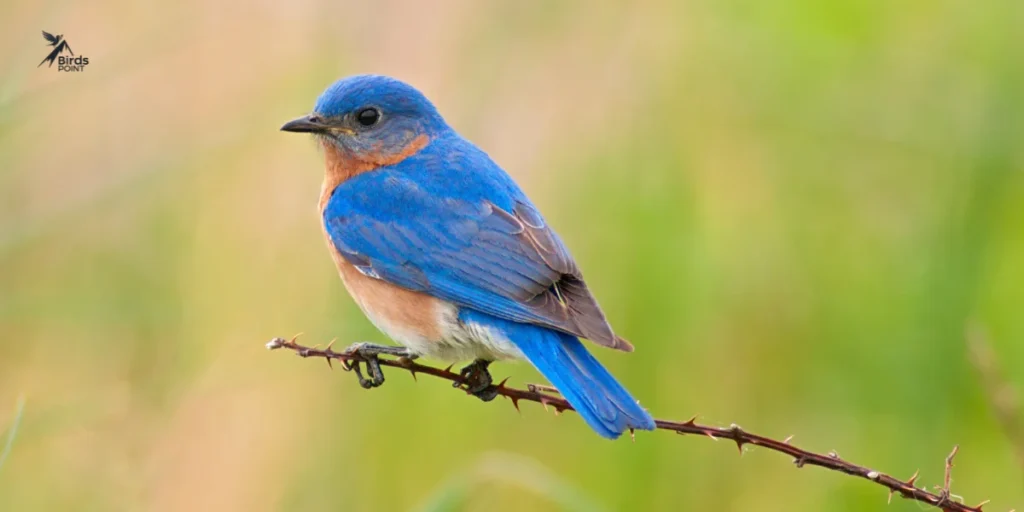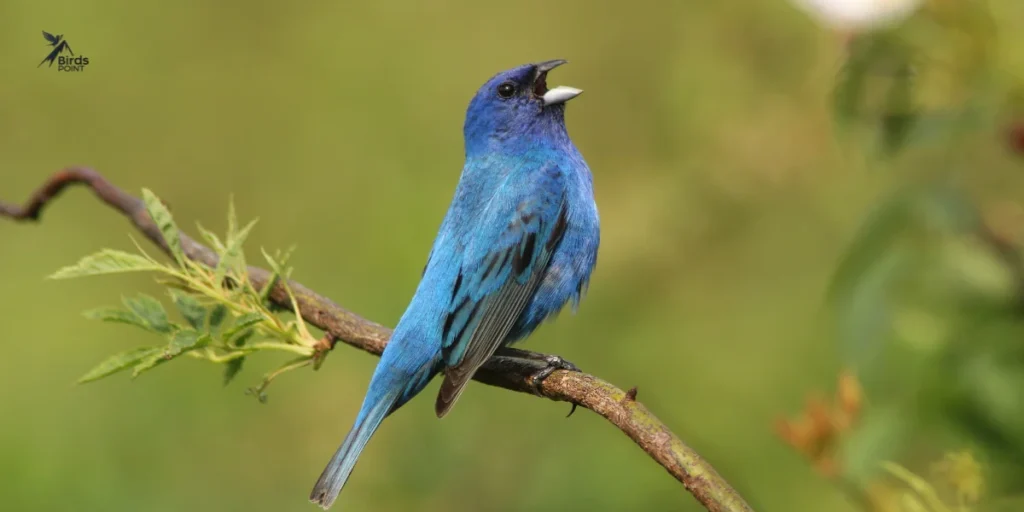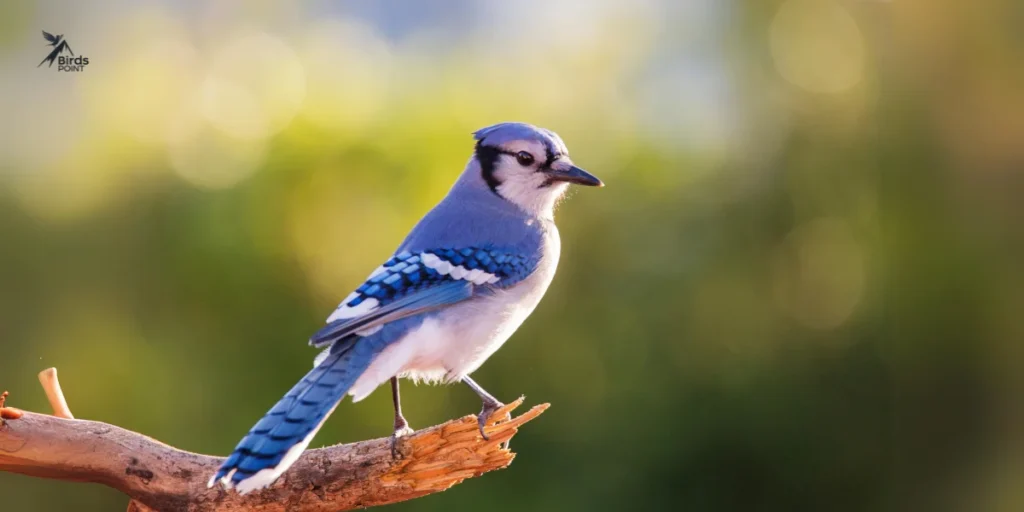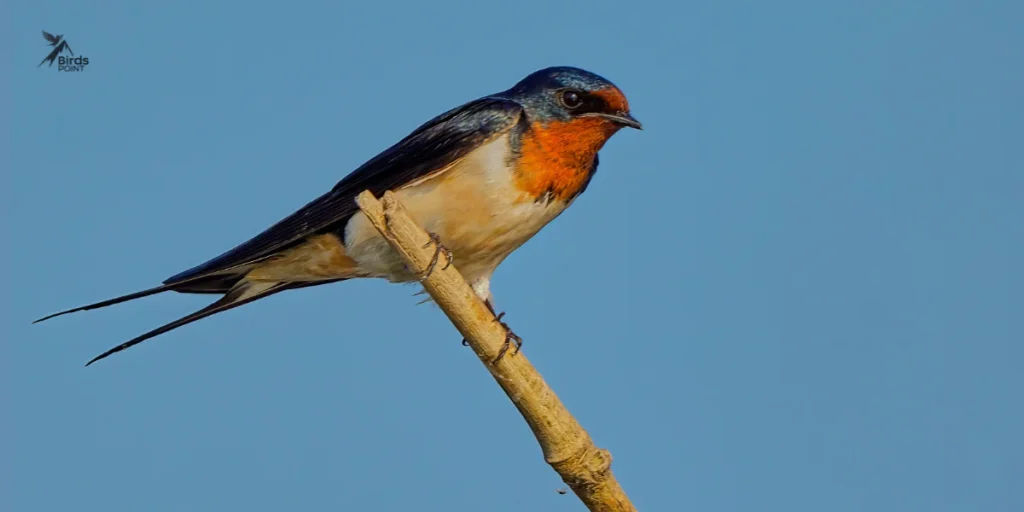Bluebirds are beautiful little birds with bright blue feathers. In Indiana, these birds are a common sight, especially in gardens, parks, and open fields. They are known for their cheerful songs and friendly behavior. Bluebirds love to live in places where there are lots of trees, and they often make their nests in small holes in trees or special birdhouses. Many people in Indiana enjoy watching bluebirds because they bring a touch of color and happiness to the outdoors.
5 Bluebirds of Indiana
| No. | Species | Description |
|---|---|---|
| 1 | Eastern Bluebird | Bright blue feathers, orange chest, common in open fields. |
| 2 | Indigo Bunting | Deep blue color, small songbird often found in woodland edges. |
| 3 | Blue Jay | Larger bird with bright blue feathers and a loud call. |
| 4 | Tree Swallow | Iridescent blue back with white underparts, often near water. |
| 5 | Barn Swallow | Blue-black feathers with long tail and found near barns. |
Top 5 Species of Blue-Colored Birds in Indiana
Blue-colored birds are a wonderful sight in Indiana. While the Eastern Bluebird is the most famous, there are other species with striking blue feathers that can be found in the state. Below is a detailed description of the top 5 species of blue-colored birds in Indiana. These birds are not only beautiful but also play an important role in the environment. Let’s explore them in detail.
1. Eastern Bluebird
Appearance
The Eastern Bluebird is a small, vibrant bird that has bright blue feathers on its back and head, with an orange-brown chest and white belly. The males are more brightly colored than the females, which are usually paler in comparison.

Habitat
Eastern Bluebirds are commonly found in open fields, farmlands, orchards, and even in suburban areas with large gardens. They prefer areas with scattered trees and open spaces, as these environments are ideal for finding food and building nests.
Behavior
Eastern Bluebirds are known for their pleasant and soft songs. They are often seen perched on wires or low branches, watching for insects. When they spot their prey, they swoop down quickly to catch it. Eastern Bluebirds eat a variety of food, including insects like beetles, grasshoppers, and spiders, as well as fruits and berries.
Nesting
Eastern Bluebirds typically nest in tree cavities or birdhouses. They prefer nesting in places where there is some protection from predators like cats and raccoons. Many people in Indiana set up special bluebird boxes to attract them to their gardens.
Importance
Eastern Bluebirds are essential in controlling insect populations, making them beneficial to farmers and gardeners. By eating insects, they help protect crops and plants.
| Category | Details |
|---|---|
| Scientific Name | Sialia sialis |
| Lifespan | 6 to 10 years |
| Size | 6.3 to 8.3 inches (16 to 21 cm) |
| Wingspan | 9.8 to 12.6 inches (25 to 32 cm) |
| Weight | 1.0 to 1.1 ounces (28 to 32 grams) |
| Diet | Insects, berries, small fruits |
| Habitat | Open fields, orchards, gardens |
| Behavior | Territorial, friendly, often uses birdhouses |
| Breeding Season | March to August |
| Conservation Status | Least Concern |
2. Indigo Bunting
Appearance
The Indigo Bunting is a small bird, with adult males having a brilliant blue color during the breeding season. This vibrant blue makes them stand out, especially during the spring and summer. Females and young males are brownish in color, with only a hint of blue, making them harder to spot.

Habitat
Indigo Buntings prefer woodland edges, open fields, and areas with plenty of shrubs. In Indiana, they are often found in parks, gardens, and areas with low, dense vegetation. They like to stay in sunny areas where they can easily find seeds and insects.
Behavior
Indigo Buntings are primarily seed-eaters, though they will also eat insects and small fruits. They are known for their cheerful songs, which they use to communicate with other birds and to mark their territory. These birds often fly low and can be seen hopping around the ground in search of food.
Nesting
These birds build their nests low to the ground in shrubs or bushes. The female is responsible for building the nest, which is made of grass, leaves, and other plant material. She lays around 3-4 eggs, and the babies are ready to leave the nest after about two weeks.
Importance
Indigo Buntings are important for seed dispersal as they help spread seeds from the fruits and plants they eat. They also add beauty to Indiana’s landscapes with their striking blue color and melodic songs.
| Category | Details |
|---|---|
| Scientific Name | Passerina cyanea |
| Lifespan | 3 to 5 years |
| Size | 4.5 to 5.1 inches (11.5 to 13 cm) |
| Wingspan | 7.5 to 8.7 inches (19 to 22 cm) |
| Weight | 0.4 to 0.6 ounces (12 to 18 grams) |
| Diet | Seeds, insects, small fruits |
| Habitat | Woodland edges, fields, gardens |
| Behavior | Migratory, sings melodic songs |
| Breeding Season | May to September |
| Conservation Status | Least Concern |
3. Blue Jay
Appearance
Blue Jays are larger birds with bright blue feathers, white underparts, and a black collar around their neck. They also have a distinct crest on their head, which they can raise or lower depending on their mood. Their wings and tail are beautifully patterned with white and black markings.

Habitat
Blue Jays are highly adaptable and can live in a variety of habitats. In Indiana, they are commonly found in forests, woodlands, parks, and even suburban areas. They prefer areas with large trees where they can find acorns, nuts, and seeds, their primary food sources.
Behavior
Blue Jays are known for their intelligence and bold behavior. They are curious birds that can mimic the calls of other birds, including hawks, to scare away predators or competitors. Blue Jays are also very social and can often be seen in groups, especially during the fall when they gather to collect food for the winter.
Nesting
Blue Jays build their nests high up in trees, using twigs, leaves, and other plant material. Both the male and female work together to build the nest. The female lays 4-6 eggs, and both parents take turns feeding the young.
Importance
Blue Jays play a vital role in spreading seeds, especially acorns, which helps in the growth of new trees. Their loud calls can also warn other birds of potential dangers, acting as a neighborhood alarm system.
| Category | Details |
|---|---|
| Scientific Name | Cyanocitta cristata |
| Lifespan | 7 to 10 years |
| Size | 9 to 12 inches (22 to 30 cm) |
| Wingspan | 13 to 17 inches (34 to 43 cm) |
| Weight | 2.5 to 3.5 ounces (70 to 100 grams) |
| Diet | Seeds, nuts, insects, small vertebrates |
| Habitat | Forests, parks, suburban areas |
| Behavior | Social, intelligent, mimics other bird calls |
| Breeding Season | April to July |
| Conservation Status | Least Concern |
4. Tree Swallow
Appearance
Tree Swallows are small, sleek birds with iridescent blue-green feathers on their back and white underparts. Their long wings and streamlined bodies make them excellent fliers. Males are slightly more colorful than females, though both have beautiful blue plumage.

Habitat
Tree Swallows are commonly found near water bodies such as lakes, rivers, and wetlands. In Indiana, they prefer areas with plenty of open spaces for flying and hunting insects. They also need dead trees or birdhouses for nesting, as they are cavity-nesters.
Behavior
These birds are highly acrobatic in the air, and they are often seen darting and swooping over fields and water, catching insects mid-flight. Tree Swallows feed mainly on flying insects like flies, beetles, and mosquitoes, making them helpful for controlling pest populations.
Nesting
Tree Swallows build their nests in natural cavities or birdhouses. They often line their nests with feathers, which provide warmth and comfort for their young. The female lays 4-7 eggs, and the chicks stay in the nest for about three weeks before they are ready to fly.
Importance
Tree Swallows are important for controlling insect populations, particularly mosquitoes and other pests. Their presence near water bodies also makes them indicators of a healthy environment.
| Category | Details |
|---|---|
| Scientific Name | Tachycineta bicolor |
| Lifespan | 2 to 6 years |
| Size | 4.7 to 5.9 inches (12 to 15 cm) |
| Wingspan | 11.8 to 13.8 inches (30 to 35 cm) |
| Weight | 0.6 to 0.8 ounces (17 to 25 grams) |
| Diet | Flying insects, berries |
| Habitat | Wetlands, fields, near water bodies |
| Behavior | Fast fliers, highly acrobatic |
| Breeding Season | May to August |
| Conservation Status | Least Concern |
5. Barn Swallow
Appearance
The Barn Swallow is a small bird with a deep blue-black back, a rusty-orange throat, and long, forked tail feathers. This forked tail distinguishes them from other swallow species. Their underparts are light brown or beige, and they have a sleek, streamlined body ideal for flight.

Habitat
Barn Swallows are often found around barns, bridges, and other man-made structures where they can build their nests. In Indiana, they prefer open fields, farmlands, and areas with access to water, as this environment provides them with plenty of insects to feed on.
Behavior
Barn Swallows are excellent fliers and are known for their graceful and fast flying. They often skim low over fields and water, catching insects in the air. They feed mostly on flying insects like flies and moths, which they catch in mid-air.
Nesting
Barn Swallows build their nests out of mud and straw, attaching them to vertical surfaces like the walls of barns, bridges, or buildings. They usually return to the same nesting site year after year. The female lays 4-5 eggs, and both parents help feed the chicks once they hatch.
Importance
Barn Swallows help control insect populations, making them beneficial for farmers and rural areas. They are also great indicators of a healthy environment since they thrive in areas with abundant insect life.
| Category | Details |
|---|---|
| Scientific Name | Hirundo rustica |
| Lifespan | 4 to 8 years |
| Size | 5.9 to 7.5 inches (15 to 19 cm) |
| Wingspan | 11.4 to 12.6 inches (29 to 32 cm) |
| Weight | 0.6 to 0.7 ounces (17 to 20 grams) |
| Diet | Flying insects |
| Habitat | Farmlands, barns, near water |
| Behavior | Graceful fliers, build mud nests |
| Breeding Season | May to September |
| Conservation Status | Least Concern |
Conclusion
Indiana is home to a variety of blue-colored birds that brighten up the skies and fields with their striking colors and charming songs. From the friendly Eastern Bluebird to the intelligent Blue Jay, each species plays a crucial role in maintaining the balance of nature. These birds are not only beautiful but also contribute to controlling pests, spreading seeds, and maintaining healthy ecosystems.
By learning more about these birds and their habits, we can appreciate their importance and work to protect their habitats. Many people in Indiana set up birdhouses, plant native plants, and avoid using harmful pesticides to help these birds thrive. Watching bluebirds and other blue-colored birds in the wild can bring joy and remind us of the beauty of nature right in our own backyards.
FAQs
1. What are the two common bluebird species in Indiana?
The Eastern Bluebird and Indigo Bunting are the most common blue-colored birds in Indiana.
2. Where can I spot bluebirds in Indiana?
You can find bluebirds in open fields, gardens, parks, and near wooded areas across the state.
3. What do bluebirds eat?
Bluebirds primarily eat insects, but they also enjoy berries and small fruits.
4. Do bluebirds migrate from Indiana?
Yes, many bluebirds migrate south during the winter but may stay in Indiana if food is available.
5. How can I attract bluebirds to my yard?
Set up birdhouses and plant native plants that provide berries and shelter.
